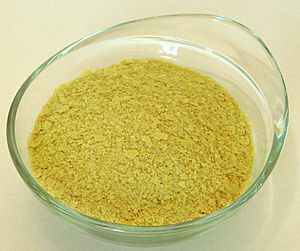Nutritional yeast facts for kids

Nutritional yeast is a special kind of yeast that you can eat! People often call it nooch for short. It's usually a type of yeast called Saccharomyces cerevisiae. But don't worry, it's not the same as the yeast used for baking bread. This yeast is "deactivated," meaning it's not alive anymore.
You can find nutritional yeast as yellow flakes, granules, or powder. It's often sold in health food stores. It's super popular with vegans and vegetarians. They use it as an ingredient in recipes or sprinkle it on food like a condiment.
Nutritional yeast has a strong, unique flavor. Many people say it tastes nutty or cheesy. This makes it a great ingredient for cheese substitutes. Vegans often use it instead of cheese. You can put it on mashed potatoes, scrambled tofu, or even popcorn!
It's also a good source of some B-complex vitamins. These vitamins are important for your body to work well. Sometimes, nutritional yeast is even fortified with vitamin B12. This is another reason why vegans love it, as B12 can be harder to get on a plant-based diet.
In Australia, it's sometimes called "savoury yeast flakes." In New Zealand, it's known as Brufax. Nutritional yeast is different from yeast extract. Nutritional yeast uses the whole yeast cell. Yeast extract is just the concentrated flavor parts of the yeast cell.
How Nutritional Yeast is Made
Making nutritional yeast is a cool process. First, a special type of yeast is grown in a nutrient-rich liquid. This liquid often contains glucose, which comes from things like sugarcane or beet molasses. The yeast grows for several days, getting bigger and bigger.
Once the yeast is ready, it's heated up. This heat "deactivates" the yeast, meaning it stops growing and is no longer alive. After that, the yeast is harvested, washed carefully, dried, and then packaged. The type of yeast used is usually a strain of Saccharomyces cerevisiae. These strains are chosen specifically for their good qualities as a food product. They are different from the strains used to make bread or beer.
What's Inside: Nutrition Facts
| Nutritional value per 15 g | |
|---|---|
| Energy | 250 kJ (60 kcal) |
|
5 g
|
|
| Sugars | 0 g |
| Dietary fibre | 3 g |
|
0.5 g
|
|
|
Protein
|
8 g
|
| Vitamins | Quantity
%DV†
|
| Thiamine (B1) |
1035%
11.9 mg |
| Riboflavin (B2) |
808%
9.7 mg |
| Niacin (B3) |
288%
46 mg |
| Vitamin B6 |
454%
5.9 mg |
| Vitamin B12 |
733%
17.6 μg |
| Minerals | Quantity
%DV†
|
| Calcium |
1%
6 mg |
| Iron |
8%
1 mg |
| Potassium |
1%
25 mg |
| Sodium |
2%
25 mg |
| Other constituents | Quantity |
| Cholesterol | 0 mg |
|
Bob's Red Mill brand, manufacturer reported values. See also SR LEGACY data for yeast (active dry #1103594) for an idea about pre-fortification values and nutrients not reported above. SR surveys are performed by unbiased USDA personnel.
|
|
| †Percentages estimated using US recommendations for adults. | |
The exact nutritional values of nutritional yeast can be a little different depending on the brand. But generally, two tablespoons (about 30 ml) give you about 60 calories. They also provide five grams of carbohydrates and four grams of fiber.
One serving also has about 9 grams of protein. This protein is special because it's a "complete protein." This means it has all nine amino acids that your body needs but can't make itself.
Nutritional yeast can be "fortified" or "unfortified." Fortified means extra vitamins have been added. Both kinds have iron. But fortified yeast gives you about 20% of the iron you need each day. Unfortified yeast gives you about 5%. Unfortified nutritional yeast also provides a lot of vitamins B1 and B2.
Many vegans use nutritional yeast to get vitamin B12. It's important to know that yeast itself doesn't naturally make B12. Only certain bacteria can produce it. So, if a brand of nutritional yeast has B12, it means the vitamin was made separately and then added to the yeast. Not all brands are fortified with B12, so always check the label!
See also
 In Spanish: Levadura nutricional para niños
In Spanish: Levadura nutricional para niños


